ENGT5219 - Sustainable Business Models Analysis in Engineering Sector
VerifiedAdded on 2023/06/04
|19
|3694
|382
Report
AI Summary
This report provides an analysis of sustainable business models applicable to the engineering environment, with a focus on corporate social responsibility and environmental considerations. It discusses various approaches such as the triple bottom line, five capitals, natural capitalism, cradle-to-cradle, and the circular economy, evaluating their effectiveness in promoting clean growth and sustainable development. The report further explores the application of the cradle-to-cradle approach and the balance scorecard within Kellogg's, a breakfast cereal manufacturing company, examining their potential environmental impact, purpose, risks, and responsibilities. The analysis includes a comparison of these models and concludes with insights on achieving sustainable growth through effective waste management, resource optimization, and innovation in alignment with environmental regulations.
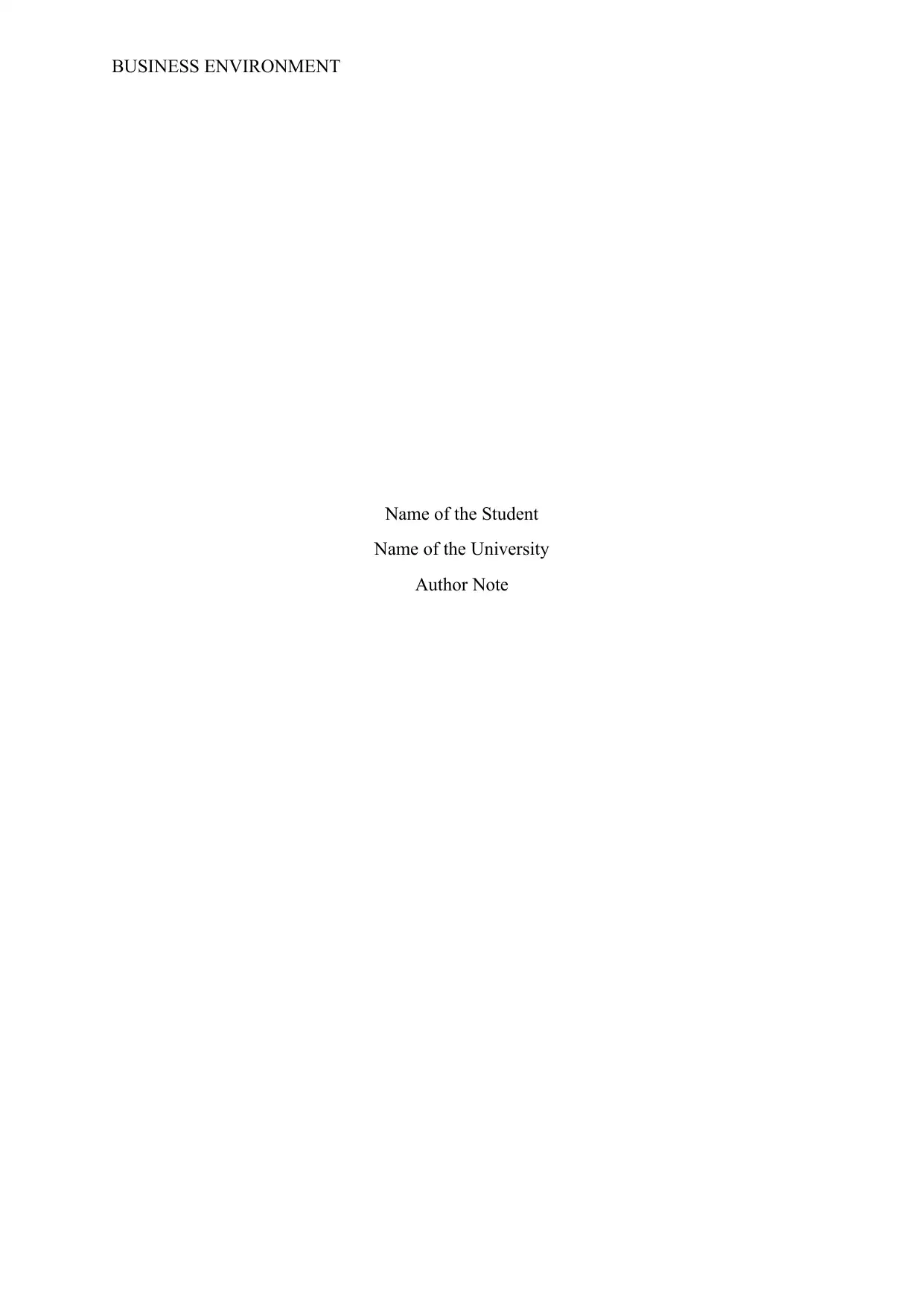
BUSINESS ENVIRONMENT
Name of the Student
Name of the University
Author Note
Name of the Student
Name of the University
Author Note
Paraphrase This Document
Need a fresh take? Get an instant paraphrase of this document with our AI Paraphraser
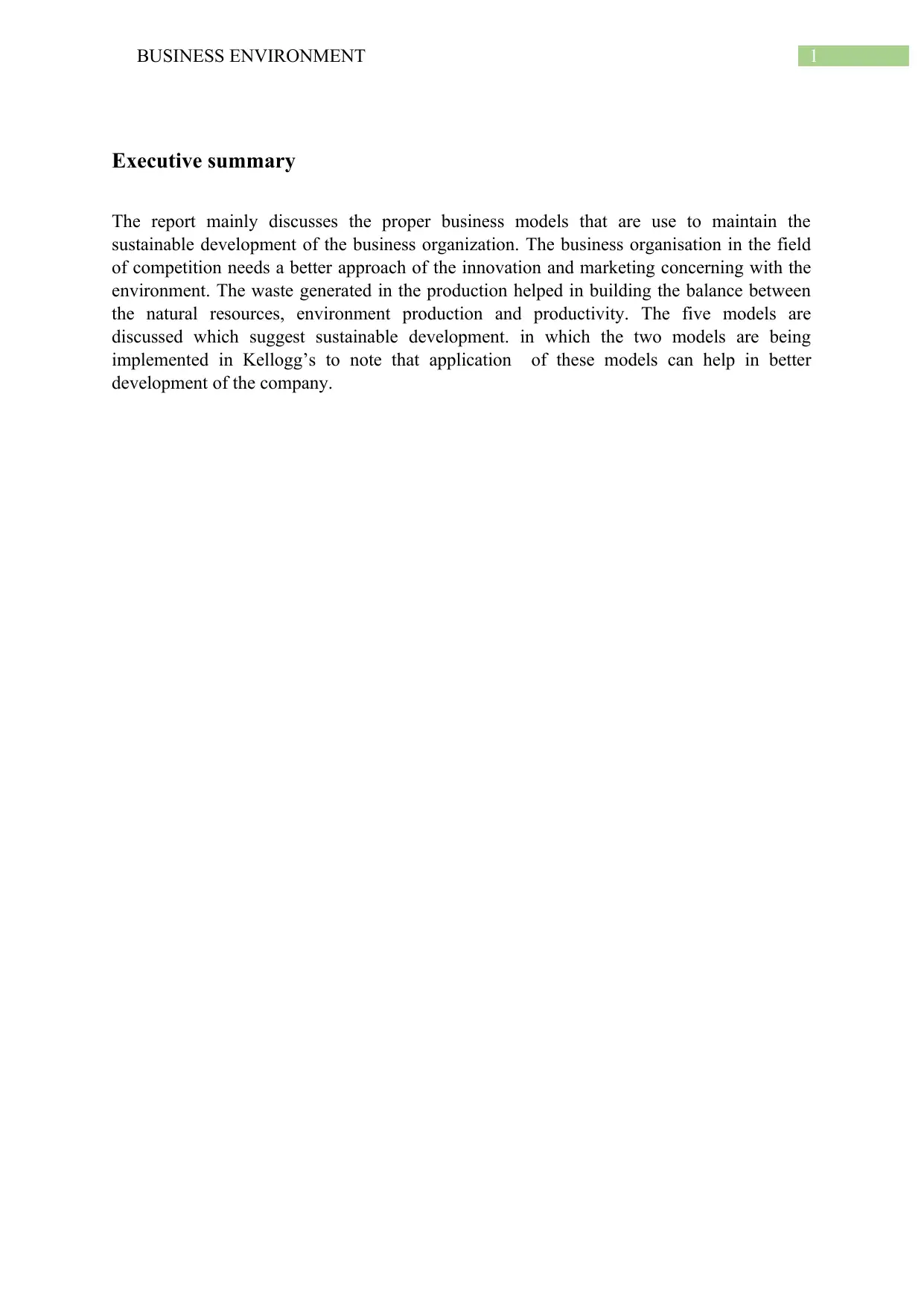
1BUSINESS ENVIRONMENT
Executive summary
The report mainly discusses the proper business models that are use to maintain the
sustainable development of the business organization. The business organisation in the field
of competition needs a better approach of the innovation and marketing concerning with the
environment. The waste generated in the production helped in building the balance between
the natural resources, environment production and productivity. The five models are
discussed which suggest sustainable development. in which the two models are being
implemented in Kellogg’s to note that application of these models can help in better
development of the company.
Executive summary
The report mainly discusses the proper business models that are use to maintain the
sustainable development of the business organization. The business organisation in the field
of competition needs a better approach of the innovation and marketing concerning with the
environment. The waste generated in the production helped in building the balance between
the natural resources, environment production and productivity. The five models are
discussed which suggest sustainable development. in which the two models are being
implemented in Kellogg’s to note that application of these models can help in better
development of the company.
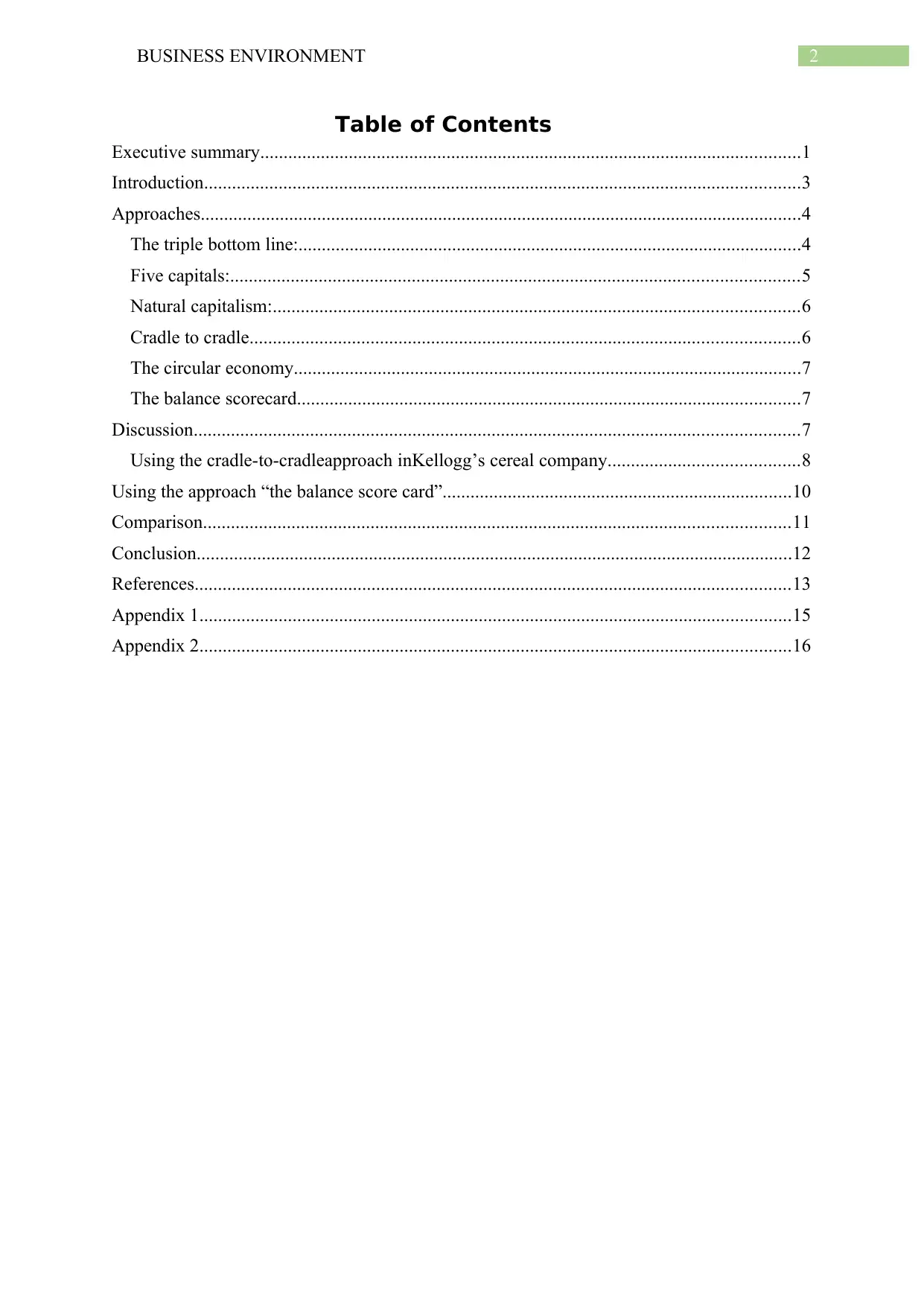
2BUSINESS ENVIRONMENT
Table of Contents
Executive summary....................................................................................................................1
Introduction................................................................................................................................3
Approaches.................................................................................................................................4
The triple bottom line:............................................................................................................4
Five capitals:..........................................................................................................................5
Natural capitalism:.................................................................................................................6
Cradle to cradle......................................................................................................................6
The circular economy.............................................................................................................7
The balance scorecard............................................................................................................7
Discussion..................................................................................................................................7
Using the cradle-to-cradleapproach inKellogg’s cereal company.........................................8
Using the approach “the balance score card”...........................................................................10
Comparison..............................................................................................................................11
Conclusion................................................................................................................................12
References................................................................................................................................13
Appendix 1...............................................................................................................................15
Appendix 2...............................................................................................................................16
Table of Contents
Executive summary....................................................................................................................1
Introduction................................................................................................................................3
Approaches.................................................................................................................................4
The triple bottom line:............................................................................................................4
Five capitals:..........................................................................................................................5
Natural capitalism:.................................................................................................................6
Cradle to cradle......................................................................................................................6
The circular economy.............................................................................................................7
The balance scorecard............................................................................................................7
Discussion..................................................................................................................................7
Using the cradle-to-cradleapproach inKellogg’s cereal company.........................................8
Using the approach “the balance score card”...........................................................................10
Comparison..............................................................................................................................11
Conclusion................................................................................................................................12
References................................................................................................................................13
Appendix 1...............................................................................................................................15
Appendix 2...............................................................................................................................16
⊘ This is a preview!⊘
Do you want full access?
Subscribe today to unlock all pages.

Trusted by 1+ million students worldwide

3BUSINESS ENVIRONMENT
Paraphrase This Document
Need a fresh take? Get an instant paraphrase of this document with our AI Paraphraser

4BUSINESS ENVIRONMENT

5BUSINESS ENVIRONMENT
⊘ This is a preview!⊘
Do you want full access?
Subscribe today to unlock all pages.

Trusted by 1+ million students worldwide
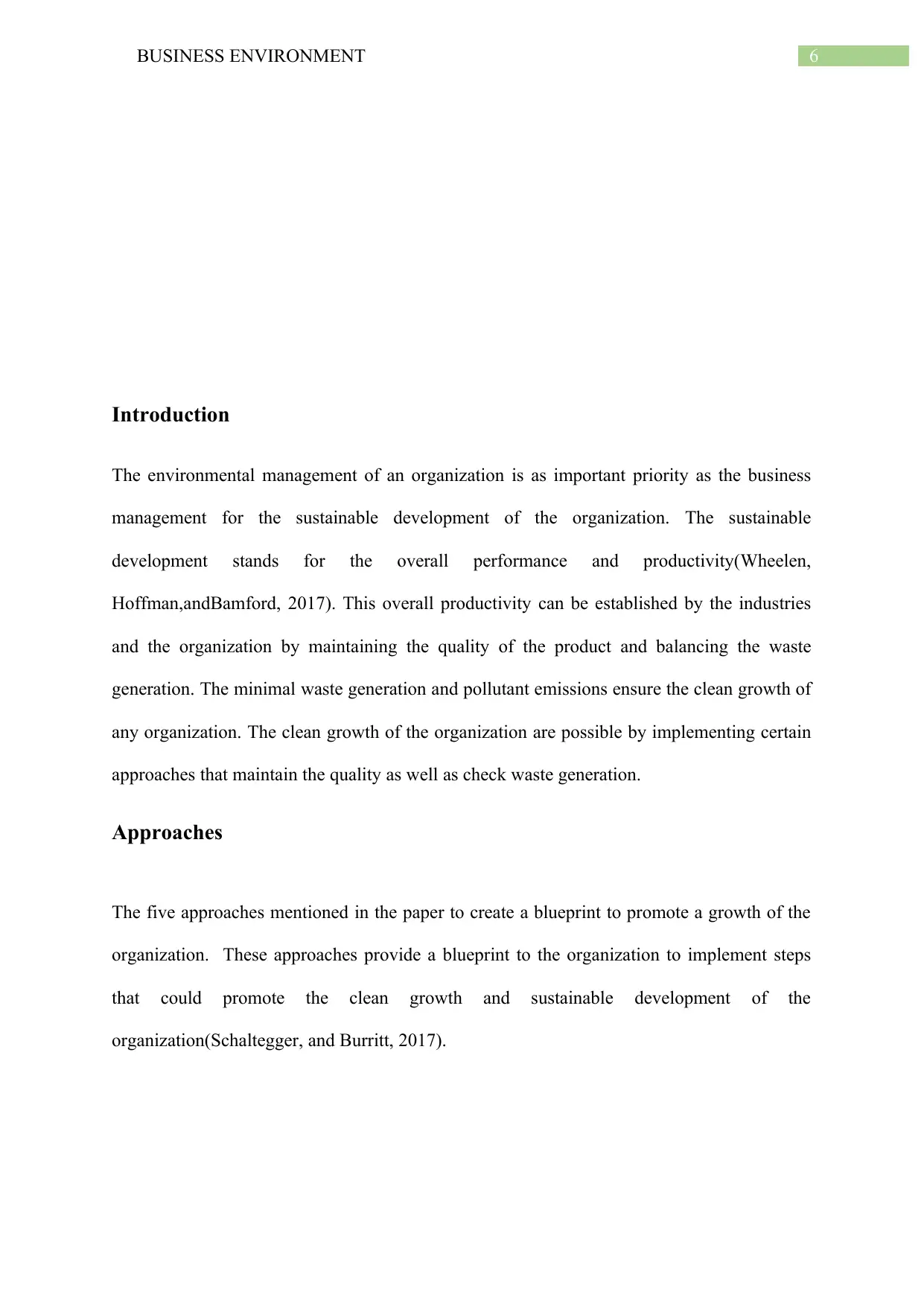
6BUSINESS ENVIRONMENT
Introduction
The environmental management of an organization is as important priority as the business
management for the sustainable development of the organization. The sustainable
development stands for the overall performance and productivity(Wheelen,
Hoffman,andBamford, 2017). This overall productivity can be established by the industries
and the organization by maintaining the quality of the product and balancing the waste
generation. The minimal waste generation and pollutant emissions ensure the clean growth of
any organization. The clean growth of the organization are possible by implementing certain
approaches that maintain the quality as well as check waste generation.
Approaches
The five approaches mentioned in the paper to create a blueprint to promote a growth of the
organization. These approaches provide a blueprint to the organization to implement steps
that could promote the clean growth and sustainable development of the
organization(Schaltegger, and Burritt, 2017).
Introduction
The environmental management of an organization is as important priority as the business
management for the sustainable development of the organization. The sustainable
development stands for the overall performance and productivity(Wheelen,
Hoffman,andBamford, 2017). This overall productivity can be established by the industries
and the organization by maintaining the quality of the product and balancing the waste
generation. The minimal waste generation and pollutant emissions ensure the clean growth of
any organization. The clean growth of the organization are possible by implementing certain
approaches that maintain the quality as well as check waste generation.
Approaches
The five approaches mentioned in the paper to create a blueprint to promote a growth of the
organization. These approaches provide a blueprint to the organization to implement steps
that could promote the clean growth and sustainable development of the
organization(Schaltegger, and Burritt, 2017).
Paraphrase This Document
Need a fresh take? Get an instant paraphrase of this document with our AI Paraphraser
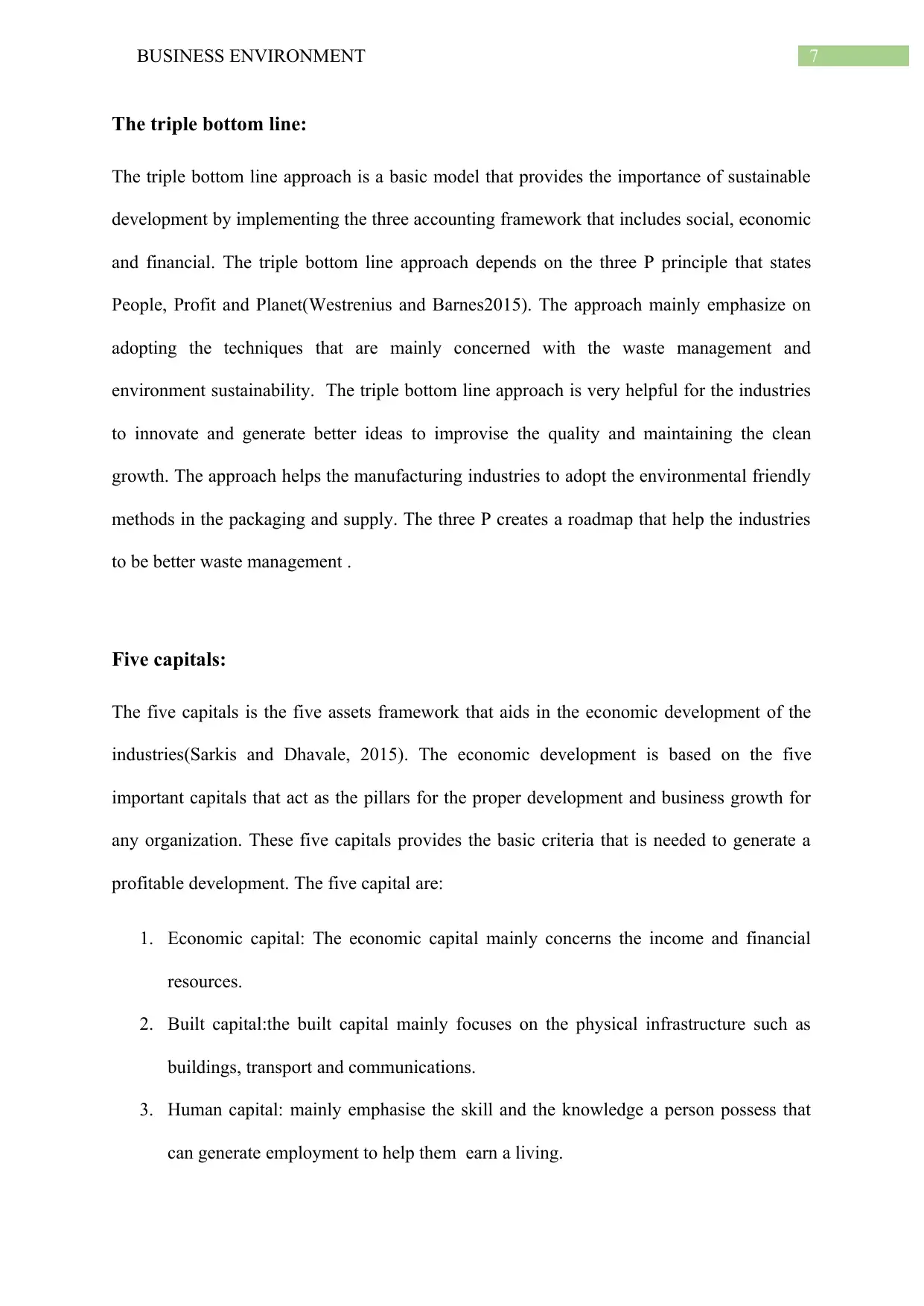
7BUSINESS ENVIRONMENT
The triple bottom line:
The triple bottom line approach is a basic model that provides the importance of sustainable
development by implementing the three accounting framework that includes social, economic
and financial. The triple bottom line approach depends on the three P principle that states
People, Profit and Planet(Westrenius and Barnes2015). The approach mainly emphasize on
adopting the techniques that are mainly concerned with the waste management and
environment sustainability. The triple bottom line approach is very helpful for the industries
to innovate and generate better ideas to improvise the quality and maintaining the clean
growth. The approach helps the manufacturing industries to adopt the environmental friendly
methods in the packaging and supply. The three P creates a roadmap that help the industries
to be better waste management .
Five capitals:
The five capitals is the five assets framework that aids in the economic development of the
industries(Sarkis and Dhavale, 2015). The economic development is based on the five
important capitals that act as the pillars for the proper development and business growth for
any organization. These five capitals provides the basic criteria that is needed to generate a
profitable development. The five capital are:
1. Economic capital: The economic capital mainly concerns the income and financial
resources.
2. Built capital:the built capital mainly focuses on the physical infrastructure such as
buildings, transport and communications.
3. Human capital: mainly emphasise the skill and the knowledge a person possess that
can generate employment to help them earn a living.
The triple bottom line:
The triple bottom line approach is a basic model that provides the importance of sustainable
development by implementing the three accounting framework that includes social, economic
and financial. The triple bottom line approach depends on the three P principle that states
People, Profit and Planet(Westrenius and Barnes2015). The approach mainly emphasize on
adopting the techniques that are mainly concerned with the waste management and
environment sustainability. The triple bottom line approach is very helpful for the industries
to innovate and generate better ideas to improvise the quality and maintaining the clean
growth. The approach helps the manufacturing industries to adopt the environmental friendly
methods in the packaging and supply. The three P creates a roadmap that help the industries
to be better waste management .
Five capitals:
The five capitals is the five assets framework that aids in the economic development of the
industries(Sarkis and Dhavale, 2015). The economic development is based on the five
important capitals that act as the pillars for the proper development and business growth for
any organization. These five capitals provides the basic criteria that is needed to generate a
profitable development. The five capital are:
1. Economic capital: The economic capital mainly concerns the income and financial
resources.
2. Built capital:the built capital mainly focuses on the physical infrastructure such as
buildings, transport and communications.
3. Human capital: mainly emphasise the skill and the knowledge a person possess that
can generate employment to help them earn a living.
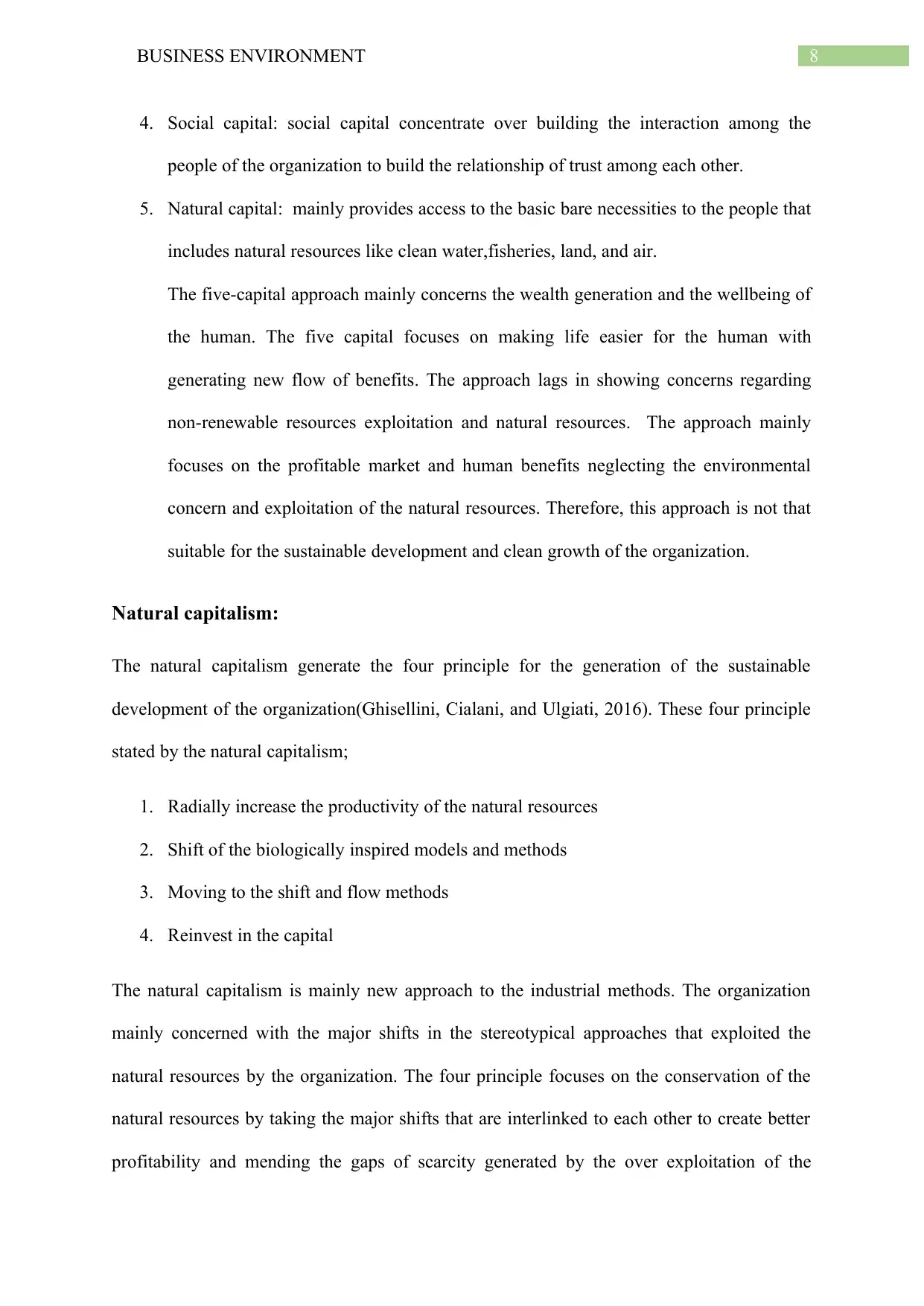
8BUSINESS ENVIRONMENT
4. Social capital: social capital concentrate over building the interaction among the
people of the organization to build the relationship of trust among each other.
5. Natural capital: mainly provides access to the basic bare necessities to the people that
includes natural resources like clean water,fisheries, land, and air.
The five-capital approach mainly concerns the wealth generation and the wellbeing of
the human. The five capital focuses on making life easier for the human with
generating new flow of benefits. The approach lags in showing concerns regarding
non-renewable resources exploitation and natural resources. The approach mainly
focuses on the profitable market and human benefits neglecting the environmental
concern and exploitation of the natural resources. Therefore, this approach is not that
suitable for the sustainable development and clean growth of the organization.
Natural capitalism:
The natural capitalism generate the four principle for the generation of the sustainable
development of the organization(Ghisellini, Cialani, and Ulgiati, 2016). These four principle
stated by the natural capitalism;
1. Radially increase the productivity of the natural resources
2. Shift of the biologically inspired models and methods
3. Moving to the shift and flow methods
4. Reinvest in the capital
The natural capitalism is mainly new approach to the industrial methods. The organization
mainly concerned with the major shifts in the stereotypical approaches that exploited the
natural resources by the organization. The four principle focuses on the conservation of the
natural resources by taking the major shifts that are interlinked to each other to create better
profitability and mending the gaps of scarcity generated by the over exploitation of the
4. Social capital: social capital concentrate over building the interaction among the
people of the organization to build the relationship of trust among each other.
5. Natural capital: mainly provides access to the basic bare necessities to the people that
includes natural resources like clean water,fisheries, land, and air.
The five-capital approach mainly concerns the wealth generation and the wellbeing of
the human. The five capital focuses on making life easier for the human with
generating new flow of benefits. The approach lags in showing concerns regarding
non-renewable resources exploitation and natural resources. The approach mainly
focuses on the profitable market and human benefits neglecting the environmental
concern and exploitation of the natural resources. Therefore, this approach is not that
suitable for the sustainable development and clean growth of the organization.
Natural capitalism:
The natural capitalism generate the four principle for the generation of the sustainable
development of the organization(Ghisellini, Cialani, and Ulgiati, 2016). These four principle
stated by the natural capitalism;
1. Radially increase the productivity of the natural resources
2. Shift of the biologically inspired models and methods
3. Moving to the shift and flow methods
4. Reinvest in the capital
The natural capitalism is mainly new approach to the industrial methods. The organization
mainly concerned with the major shifts in the stereotypical approaches that exploited the
natural resources by the organization. The four principle focuses on the conservation of the
natural resources by taking the major shifts that are interlinked to each other to create better
profitability and mending the gaps of scarcity generated by the over exploitation of the
⊘ This is a preview!⊘
Do you want full access?
Subscribe today to unlock all pages.

Trusted by 1+ million students worldwide
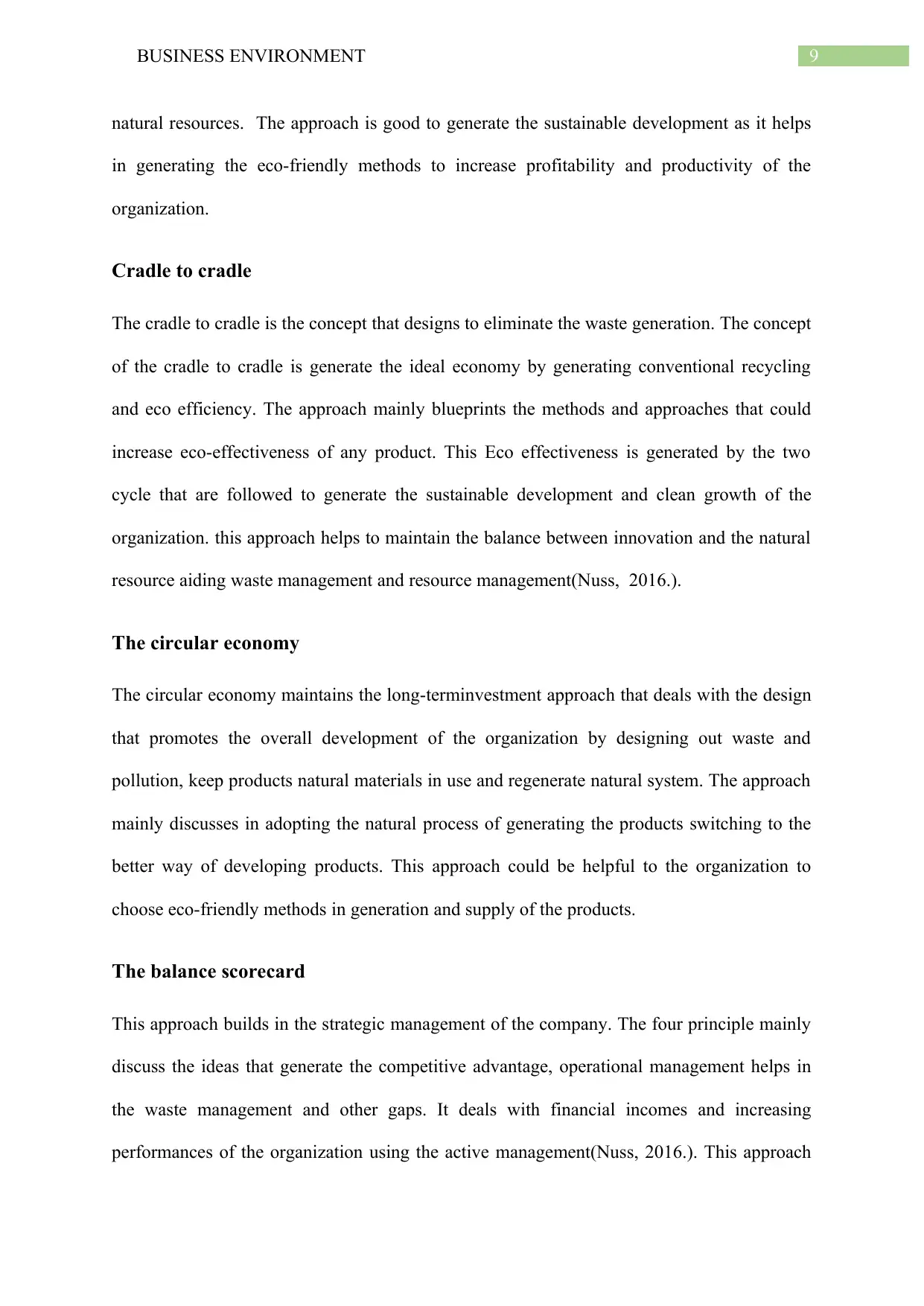
9BUSINESS ENVIRONMENT
natural resources. The approach is good to generate the sustainable development as it helps
in generating the eco-friendly methods to increase profitability and productivity of the
organization.
Cradle to cradle
The cradle to cradle is the concept that designs to eliminate the waste generation. The concept
of the cradle to cradle is generate the ideal economy by generating conventional recycling
and eco efficiency. The approach mainly blueprints the methods and approaches that could
increase eco-effectiveness of any product. This Eco effectiveness is generated by the two
cycle that are followed to generate the sustainable development and clean growth of the
organization. this approach helps to maintain the balance between innovation and the natural
resource aiding waste management and resource management(Nuss, 2016.).
The circular economy
The circular economy maintains the long-terminvestment approach that deals with the design
that promotes the overall development of the organization by designing out waste and
pollution, keep products natural materials in use and regenerate natural system. The approach
mainly discusses in adopting the natural process of generating the products switching to the
better way of developing products. This approach could be helpful to the organization to
choose eco-friendly methods in generation and supply of the products.
The balance scorecard
This approach builds in the strategic management of the company. The four principle mainly
discuss the ideas that generate the competitive advantage, operational management helps in
the waste management and other gaps. It deals with financial incomes and increasing
performances of the organization using the active management(Nuss, 2016.). This approach
natural resources. The approach is good to generate the sustainable development as it helps
in generating the eco-friendly methods to increase profitability and productivity of the
organization.
Cradle to cradle
The cradle to cradle is the concept that designs to eliminate the waste generation. The concept
of the cradle to cradle is generate the ideal economy by generating conventional recycling
and eco efficiency. The approach mainly blueprints the methods and approaches that could
increase eco-effectiveness of any product. This Eco effectiveness is generated by the two
cycle that are followed to generate the sustainable development and clean growth of the
organization. this approach helps to maintain the balance between innovation and the natural
resource aiding waste management and resource management(Nuss, 2016.).
The circular economy
The circular economy maintains the long-terminvestment approach that deals with the design
that promotes the overall development of the organization by designing out waste and
pollution, keep products natural materials in use and regenerate natural system. The approach
mainly discusses in adopting the natural process of generating the products switching to the
better way of developing products. This approach could be helpful to the organization to
choose eco-friendly methods in generation and supply of the products.
The balance scorecard
This approach builds in the strategic management of the company. The four principle mainly
discuss the ideas that generate the competitive advantage, operational management helps in
the waste management and other gaps. It deals with financial incomes and increasing
performances of the organization using the active management(Nuss, 2016.). This approach
Paraphrase This Document
Need a fresh take? Get an instant paraphrase of this document with our AI Paraphraser
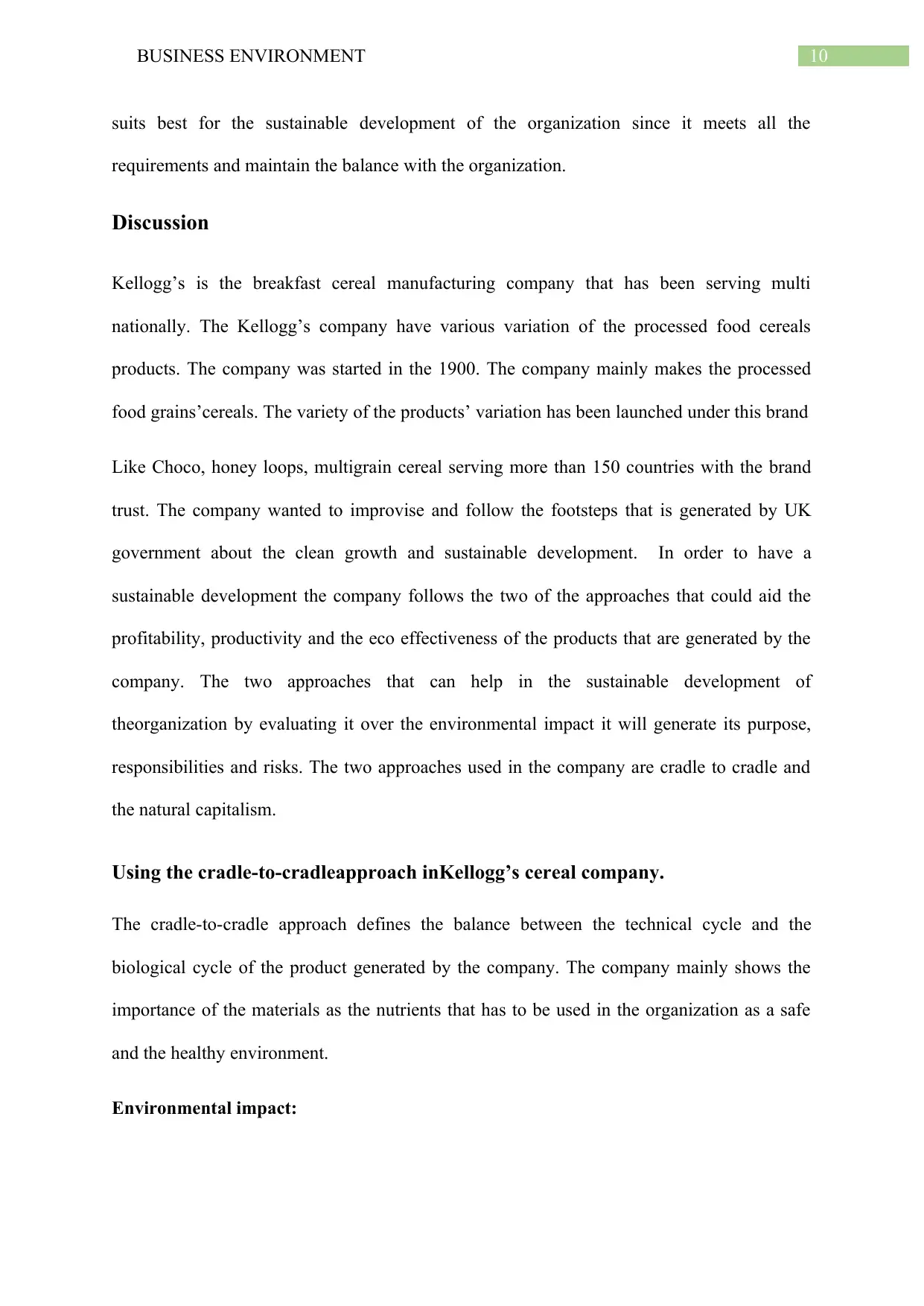
10BUSINESS ENVIRONMENT
suits best for the sustainable development of the organization since it meets all the
requirements and maintain the balance with the organization.
Discussion
Kellogg’s is the breakfast cereal manufacturing company that has been serving multi
nationally. The Kellogg’s company have various variation of the processed food cereals
products. The company was started in the 1900. The company mainly makes the processed
food grains’cereals. The variety of the products’ variation has been launched under this brand
Like Choco, honey loops, multigrain cereal serving more than 150 countries with the brand
trust. The company wanted to improvise and follow the footsteps that is generated by UK
government about the clean growth and sustainable development. In order to have a
sustainable development the company follows the two of the approaches that could aid the
profitability, productivity and the eco effectiveness of the products that are generated by the
company. The two approaches that can help in the sustainable development of
theorganization by evaluating it over the environmental impact it will generate its purpose,
responsibilities and risks. The two approaches used in the company are cradle to cradle and
the natural capitalism.
Using the cradle-to-cradleapproach inKellogg’s cereal company.
The cradle-to-cradle approach defines the balance between the technical cycle and the
biological cycle of the product generated by the company. The company mainly shows the
importance of the materials as the nutrients that has to be used in the organization as a safe
and the healthy environment.
Environmental impact:
suits best for the sustainable development of the organization since it meets all the
requirements and maintain the balance with the organization.
Discussion
Kellogg’s is the breakfast cereal manufacturing company that has been serving multi
nationally. The Kellogg’s company have various variation of the processed food cereals
products. The company was started in the 1900. The company mainly makes the processed
food grains’cereals. The variety of the products’ variation has been launched under this brand
Like Choco, honey loops, multigrain cereal serving more than 150 countries with the brand
trust. The company wanted to improvise and follow the footsteps that is generated by UK
government about the clean growth and sustainable development. In order to have a
sustainable development the company follows the two of the approaches that could aid the
profitability, productivity and the eco effectiveness of the products that are generated by the
company. The two approaches that can help in the sustainable development of
theorganization by evaluating it over the environmental impact it will generate its purpose,
responsibilities and risks. The two approaches used in the company are cradle to cradle and
the natural capitalism.
Using the cradle-to-cradleapproach inKellogg’s cereal company.
The cradle-to-cradle approach defines the balance between the technical cycle and the
biological cycle of the product generated by the company. The company mainly shows the
importance of the materials as the nutrients that has to be used in the organization as a safe
and the healthy environment.
Environmental impact:
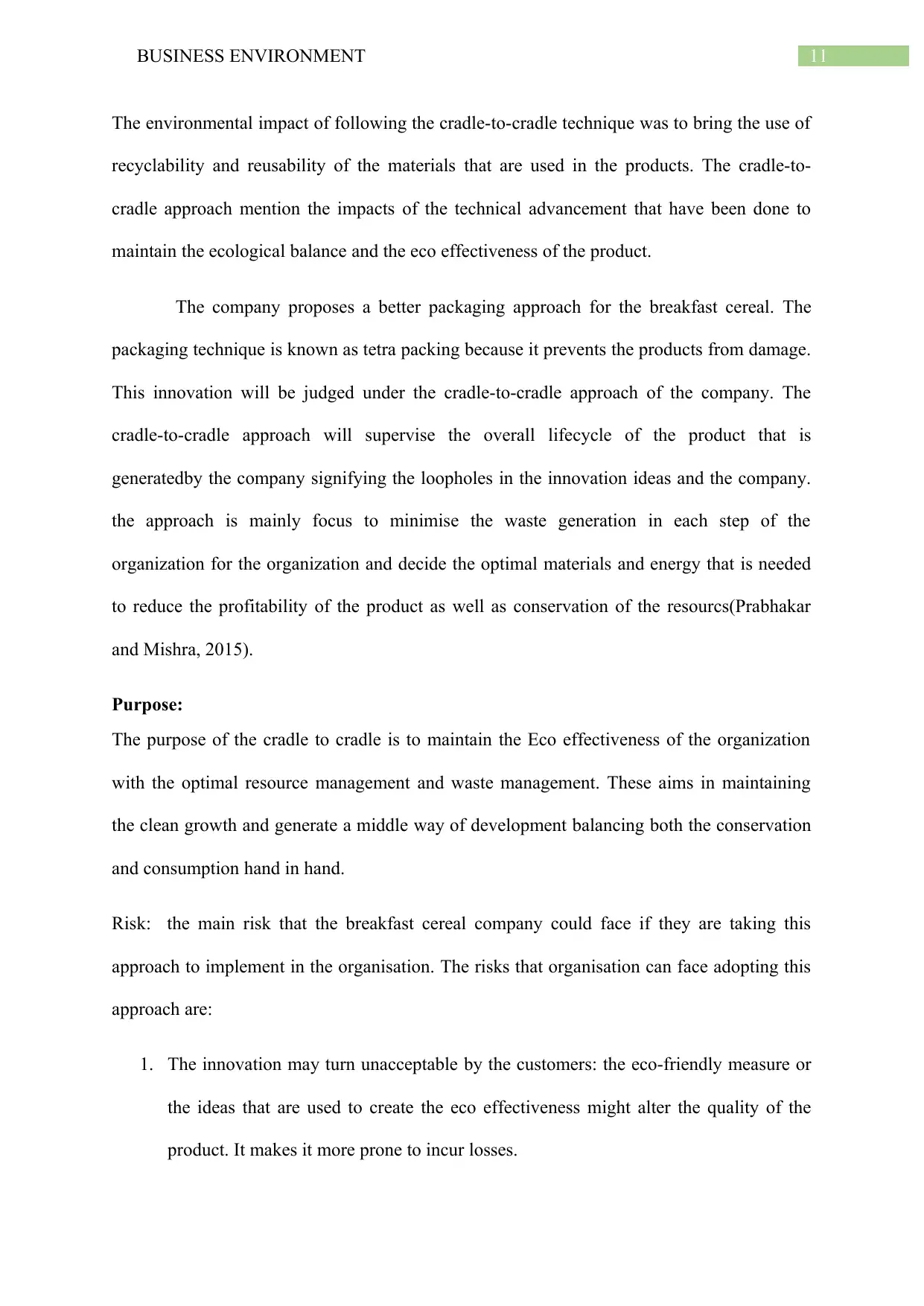
11BUSINESS ENVIRONMENT
The environmental impact of following the cradle-to-cradle technique was to bring the use of
recyclability and reusability of the materials that are used in the products. The cradle-to-
cradle approach mention the impacts of the technical advancement that have been done to
maintain the ecological balance and the eco effectiveness of the product.
The company proposes a better packaging approach for the breakfast cereal. The
packaging technique is known as tetra packing because it prevents the products from damage.
This innovation will be judged under the cradle-to-cradle approach of the company. The
cradle-to-cradle approach will supervise the overall lifecycle of the product that is
generatedby the company signifying the loopholes in the innovation ideas and the company.
the approach is mainly focus to minimise the waste generation in each step of the
organization for the organization and decide the optimal materials and energy that is needed
to reduce the profitability of the product as well as conservation of the resourcs(Prabhakar
and Mishra, 2015).
Purpose:
The purpose of the cradle to cradle is to maintain the Eco effectiveness of the organization
with the optimal resource management and waste management. These aims in maintaining
the clean growth and generate a middle way of development balancing both the conservation
and consumption hand in hand.
Risk: the main risk that the breakfast cereal company could face if they are taking this
approach to implement in the organisation. The risks that organisation can face adopting this
approach are:
1. The innovation may turn unacceptable by the customers: the eco-friendly measure or
the ideas that are used to create the eco effectiveness might alter the quality of the
product. It makes it more prone to incur losses.
The environmental impact of following the cradle-to-cradle technique was to bring the use of
recyclability and reusability of the materials that are used in the products. The cradle-to-
cradle approach mention the impacts of the technical advancement that have been done to
maintain the ecological balance and the eco effectiveness of the product.
The company proposes a better packaging approach for the breakfast cereal. The
packaging technique is known as tetra packing because it prevents the products from damage.
This innovation will be judged under the cradle-to-cradle approach of the company. The
cradle-to-cradle approach will supervise the overall lifecycle of the product that is
generatedby the company signifying the loopholes in the innovation ideas and the company.
the approach is mainly focus to minimise the waste generation in each step of the
organization for the organization and decide the optimal materials and energy that is needed
to reduce the profitability of the product as well as conservation of the resourcs(Prabhakar
and Mishra, 2015).
Purpose:
The purpose of the cradle to cradle is to maintain the Eco effectiveness of the organization
with the optimal resource management and waste management. These aims in maintaining
the clean growth and generate a middle way of development balancing both the conservation
and consumption hand in hand.
Risk: the main risk that the breakfast cereal company could face if they are taking this
approach to implement in the organisation. The risks that organisation can face adopting this
approach are:
1. The innovation may turn unacceptable by the customers: the eco-friendly measure or
the ideas that are used to create the eco effectiveness might alter the quality of the
product. It makes it more prone to incur losses.
⊘ This is a preview!⊘
Do you want full access?
Subscribe today to unlock all pages.

Trusted by 1+ million students worldwide
1 out of 19
Related Documents
Your All-in-One AI-Powered Toolkit for Academic Success.
+13062052269
info@desklib.com
Available 24*7 on WhatsApp / Email
![[object Object]](/_next/static/media/star-bottom.7253800d.svg)
Unlock your academic potential
Copyright © 2020–2025 A2Z Services. All Rights Reserved. Developed and managed by ZUCOL.





